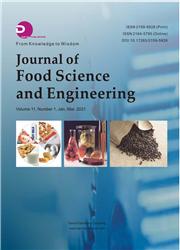Proximate and Mineral Compositions of Noodles Made from Triticum durum, Digitaria exilis, Vigna unguiculata Flour and Moringa oleifera Powder
引用次数: 7
Abstract
The objective of this study was to determine the proximate, mineral and sensory properties of noodles prepared from blends of Triticum durum (wheat), Digitaria exilis(acha), Vigna unguiculata (cowpea) flours and Moringa oleifera leaf powder (MLP). The flour samples were mixed in a four by four factorial, in complete randomized design (CRD) to formulate the composite blends at four different levels (25, 50, 75 and 100) which gave 16 samples. The flour samples were used to produce noodles and subjected to proximate, mineral and sensory analysis. Results of the proximate composition revealed that moisture content of the noodles ranged from 8.04-13.81%, ash 1.84-3.67%, fat 1.95-3.61%, crude protein 10.07-14.44%, carbohydrate 33.15-61.45%, dietary fibre 16.65-36.22% and caloric value 214.53-288.28 kJ/100 g. There was a significant increase (p < 0.05) in the moisture, ash, fat, crude protein and dietary fibre of the noodles on the substitution with cowpea flour, acha flour and MLP. Results of mineral composition also showed that sodium content ranged from 1.58-11.76 mg/100 g, potassium 26.70-40.40 mg/100 g, calcium 18.03-59.02 mg/100 g, iron 6.18-21.53 mg/100 g and phosphorus 0.51-1.54 mg/100 g. Noodle sample produced from 75% wheat and 25% cowpea flours were significantly higher (p < 0.05) in mineral content (except for potassium). Sensory evaluation results showed that cowpea and acha flours can be substituted at 25% levels with 75%, wheat flour and acha flour can as well be substituted at 50% with 50% cowpea flour while MLP at 2% with 50% wheat flour, 23% acha flour and 25% cowpea flour without significantly (p < 0.05) affected the sensory attributes of the noodles. This result therefore indicates that the use of these locally grown crops has the potential to increase the nutritional intake of consumers of this product.硬粒小麦、马地黄、木犀粉和辣木粉制成的面条的近似成分和矿物成分
本研究的目的是测定由硬粒小麦(小麦)、洋地黄(甜菜)、黑豌豆(豇豆)粉和辣木叶粉(MLP)混合制成的面条的接近性、矿物质和感官特性。面粉样品以完全随机设计(CRD)的四乘四因子混合,以配制四个不同水平(25、50、75和100)的复合混合物,得到16个样品。面粉样品用于生产面条,并进行了近红外、矿物和感官分析。接近组成的结果表明,面条的水分含量在8.04-13.81%、灰分1.84-3.67%、脂肪1.95-3.61%、粗蛋白10.07-14.44%、碳水化合物33.15-61.45%、膳食纤维16.65-36.22%和热值214.53-288.28kJ/100g之间,用豇豆粉、阿茶粉和MLP替代面条的粗蛋白和膳食纤维。矿物质组成的结果还显示,钠含量在1.58-11.76 mg/100 g之间,钾含量在26.70-40.40 mg/100 g,钙含量在18.03-59.02 mg/100 g范围内,铁含量在6.18-21.53 mg/100 g和磷含量在0.51-1.54 mg/100 g范围内。感官评价结果表明,75%的豇豆粉和acha粉可以在25%的水平上替代,50%的豇豆面粉可以在50%的水平上代替小麦粉和acha粉,而2%的MLP用50%的小麦粉、23%的acha粉和25%的豇豆面替代,对面条的感官特性没有显著影响(p<0.05)。因此,这一结果表明,使用这些当地种植的作物有可能增加该产品消费者的营养摄入。
本文章由计算机程序翻译,如有差异,请以英文原文为准。
求助全文
约1分钟内获得全文
求助全文

 求助内容:
求助内容: 应助结果提醒方式:
应助结果提醒方式:


